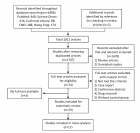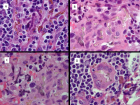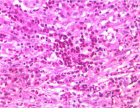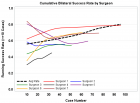Abstract
Research Article
Determination of the Potential for use of Plant Essential Oils as a Fungicide Against Fusarium Oxysporum (OG10)
Elif Tan*, Ebru Gezgincioğlu and Özlem Gülmez and Özlem Barış
Published: 22 September, 2023 | Volume 7 - Issue 3 | Pages: 107-112
This study aimed to determine whether the essential oils of thyme, ginger, and mint from medicinal aromatic plants can provide resistance to the pathogen Fusarium oxysporum in the maize plant. To this end, the antifungal effect of 0.1 ml, 0.25 ml, 0.5 ml, and 1 ml essential oil amounts was determined by the agar disc diffusion method. It was determined that concentrations containing 0.1, and 0.25 ml essential oil showed no antifungal effects, however, concentrations containing 0.5 and 1 ml essential oil had antifungal effects. The most effective concentration was found to be 1 ml of essential oil in all three species. The maize was grown under hydroponic conditions. Thyme, ginger, and mint essential oils (1 g/100 ml) were applied to the root medium of the grown maize plant on the 8th day. An F. oxysporum suspension containing 107 spores was applied after 24 hours and harvested 3 days later. When the reactive oxygen species (H2O2) and MDA amounts of the harvested plants were examined, it was observed that there was an increase in the population of F. oxysporum. However, applications of thyme, ginger, and mint essential oil have been observed to significantly reduce these. It was also determined that essential oils protected the plant against F. oxysporum by increasing antioxidant enzyme activities. Although these three essential oils applied have antifungal properties, it has been observed that the best effect belongs to thyme essential oil. The results show that essential oils of thyme ginger and mint can be used as potential fungicides against the pathogen F. oxysporum in maize cultivation
Read Full Article HTML DOI: 10.29328/journal.jpsp.1001114 Cite this Article Read Full Article PDF
Keywords:
Fungicide; F. Oxysporum; Essential oil; Antioxidant activity; Maize
References
- Hahn M. The rising threat of fungicide resistance in plant pathogenic fungi: Botrytis as a case study. J Chem Biol. 2014 May 28;7(4):133-41. doi: 10.1007/s12154-014-0113-1. PMID: 25320647; PMCID: PMC4182335.
- Shuping DSS, Eloff JN. The use of plants to protect plants and food against fungal pathogens: a review. Afr J Tradit Complement Altern Med. 2017 Jun 5;14(4):120-127. doi: 10.21010/ajtcam.v14i4.14. PMID: 28638874; PMCID: PMC5471458.
- Hamad YK, Abobakr Y, Salem MZ, Ali HM, Al-Sarar AS, Al-Zabib AA. Activity of plant extracts/essential oils against three plant pathogenic fungi and mosquito larvae: GC/MS analysis of bioactive compounds. BioResources, 2019; 14(2): 4489-4511.
- Kaur R, Kaur H. The Antimicrobial activity of essential oil and plant extracts of Woodfordia fruticosa. Arch Appl Sci Res. 2010; 2(1): 302-309.
- Hussain AI, Anwar F, Shahid M, Ashraf M, Przybylski R. Chemical composition, and antioxidant and antimicrobial activities of essential oil of spearmint (Mentha spicata) from Pakistan. Journal of Essential Oil Research. 2010; 22(1): 78-84.
- Douiri LF, Boughdad A, Alaoui MH, Moumni M. Biological activity of Rosmarinus officinalis essential oils against Callosobruchus maculatus, (Coleoptera, Bruchinae). Journal of Biology Agriculture and Healthcare. 2014; 4(2): 5-14.
- Matoušková M, Jurová J, Gruľová D, Wajs-Bonikowska A, Renčo M, Sedlák V, Poráčová J, Gogaľová Z, Kalemba D. Phytotoxic Effect of Invasive Heracleum mantegazzianumEssential Oil on Dicot and Monocot Species. Molecules. 2019 Jan 24;24(3):425. doi: 10.3390/molecules24030425. PMID: 30682808; PMCID: PMC6384721.
- Elshafie HS, Camele I. An Overview of Metabolic Activity, Beneficial and Pathogenic Aspects of Burkholderia Metabolites. 2021 May 17;11(5):321. doi: 10.3390/metabo11050321. PMID: 34067834; PMCID: PMC8156019.
- Ibáñez MD, Blázquez MA. Ginger and Turmeric Essential Oils for Weed Control and Food Crop Protection. Plants (Basel). 2019 Mar 10;8(3):59. doi: 10.3390/plants8030059. PMID: 30857365; PMCID: PMC6473496.
- Guo J, Gao Z, Li G, Fu F, Liang Z, Zhu H, Shan Y. Antimicrobial and antibiofilm efficacy and mechanism of essential oil from Citrus Changshan-huyou YB chang against Listeria monocytogenes. Food Control. 2019; 105: 256-264.
- Abdollahi M, Sefidkon F, Calagari M, Mousavi A, Mahomoodally MF. Impact of four hemp (Cannabis sativa) varieties and stage of plant growth on yield and composition of essential oils. Industrial Crops and Products. 2020;155: 112793.
- Hu Z, Yuan K, Zhou Q, Lu C, Du L, Liu F. Mechanism of antifungal activity of Perilla frutescens essential oil against Aspergillus flavus by transcriptomic analysis. Food control. 2021; 123: 107703.
- Okello PN, Petrović K, Kontz B, Mathew FM. Eight species of Fusarium cause root rot of corn (Zea mays) in South Dakota. Plant Health Progress. 2019;20(1): 38-43.
- Ngoune Tandzi L, Mutengwa CS. Estimation of maize (Zea mays L.) yield per harvest area: Appropriate methods. Agronomy. 2020; 10(1): 29.
- Matsumura S, Murata K, Zaima N, Yoshioka Y, Morimoto M, Kugo H, Yamamoto A, Moriyama T, Matsuda H. Inhibitory Activities of Essential Oil Obtained from Turmeric and Its Constituents against β-Secretase. Nat Prod Commun. 2016 Dec;11(12):1785-1788. PMID: 30508333.
- Castillo F, Hernández D, Gallegos G, Mendez M, Rodríguez R, Reyes A, Aguilar CN. In vitro antifungal activity of plant extracts obtained with alternative organic solvents against Rhizoctonia solani Kühn. Industrial Crops and Products. 2010;32(3): 324-328.
- Kim E, Park IK. Fumigant antifungal activity of Myrtaceae essential oils and constituents from Leptospermum petersonii against three Aspergillus species. Molecules. 2012 Sep 3;17(9):10459-69. doi: 10.3390/molecules170910459. PMID: 22945026; PMCID: PMC6268886.
- Heath RL, Packer L. Photoperoxidation in isolated chloroplasts. I. Kinetics and stoichiometry of fatty acid peroxidation. Arch Biochem Biophys. 1968 Apr;125(1):189-98. doi: 10.1016/0003-9861(68)90654-1. PMID: 5655425.
- Tiryaki D, Aydın İ, Atıcı Ö. Psychrotolerant bacteria isolated from the leaf apoplast of cold-adapted wild plants improve the cold resistance of bean (Phaseolus vulgaris L.) under low temperature. Cryobiology. 2019 Feb;86:111-119. doi: 10.1016/j.cryobiol.2018.11.001. Epub 2018 Nov 10. PMID: 30419217.
- He Y, Liu Y, Cao W, Huai M, Xu B, Huang B. Effects of salicylic acid on heat tolerance associated with antioxidant metabolism in Kentucky bluegrass. Crop Science. 2005; 45(3): 988-995.
- Xing F, Hua H, Selvaraj JN, Zhao Y, Zhou L, Liu X, Liu Y. Growth inhibition and morphological alterations of Fusarium verticillioides by cinnamon oil and cinnamaldehyde. Food Control. 2014; 46:343-350.
- Hassanien MF, Assiri AM, Alzohairy AM, Oraby HF. Health-promoting value and food applications of black cumin essential oil: an overview. J Food Sci Technol. 2015 Oct;52(10):6136-42. doi: 10.1007/s13197-015-1785-4. Epub 2015 Mar 27. PMID: 26396361; PMCID: PMC4573164.
- Kumar P, Mishra S, Kumar A, Sharma AK. Antifungal efficacy of plant essential oils against stored grain fungi of Fusarium J Food Sci Technol. 2016 Oct;53(10):3725-3734. doi: 10.1007/s13197-016-2347-0. Epub 2016 Oct 13. PMID: 28017987; PMCID: PMC5147695.
- Sharma A, Rajendran S, Srivastava A, Sharma S, Kundu B. Antifungal activities of selected essential oils against Fusarium oxysporum f. sp. lycopersici 1322, with emphasis on Syzygium aromaticum essential oil. J Biosci Bioeng. 2017 Mar;123(3):308-313. doi: 10.1016/j.jbiosc.2016.09.011. Epub 2016 Nov 18. PMID: 27876218.
- Katyayani KKS, Bindal S, Yaddanapudi S, Kumar V, Rana M, Srivastava S. Evaluation of bio-agents, essential oils, and chemicals against Fusarium wilt of tomato. Int J. Curr Microbiol App Sci. 2019; 8(07): 1913-1922.
- Heller J, Tudzynski P. Reactive oxygen species in phytopathogenic fungi: signaling, development, and disease. Annu Rev Phytopathol. 2011;49:369-90. doi: 10.1146/annurev-phyto-072910-095355. PMID: 21568704.
- Taheri P, Kakooee T. Reactive oxygen species accumulation and homeostasis are involved in plant immunity to an opportunistic fungal pathogen. J Plant Physiol. 2017 Sep;216:152-163. doi: 10.1016/j.jplph.2017.04.018. Epub 2017 Jun 1. PMID: 28667882.
- Segal LM, Wilson RA. Reactive oxygen species metabolism and plant-fungal interactions. Fungal Genet Biol. 2018 Jan;110:1-9. doi: 10.1016/j.fgb.2017.12.003. Epub 2017 Dec 7. PMID: 29225185.
- Samoilova Z, Smirnova G, Muzyka N, Oktyabrsky O. Medicinal plant extracts variously modulate susceptibility of Escherichia coli to different antibiotics. Microbiol Res. 2014 Apr;169(4):307-13. doi: 10.1016/j.micres.2013.06.013. Epub 2013 Jul 31. PMID: 23916388.
- Marroquin-Guzman M, Hartline D, Wright JD, Elowsky C, Bourret TJ, Wilson RA. The Magnaporthe oryzae nitrooxidative stress response suppresses rice innate immunity during blast disease. Nat Microbiol. 2017 Apr 18;2:17054. doi: 10.1038/nmicrobiol.2017.54. PMID: 28418377.
- Yan L, Li M, Cao Y, Gao P, Cao Y, Wang Y, Jiang Y. The alternative oxidase of Candida albicans causes reduced fluconazole susceptibility. J Antimicrob Chemother. 2009 Oct;64(4):764-73. doi: 10.1093/jac/dkp273. Epub 2009 Aug 5. PMID: 19656781.
- Mello EO, Ribeiro SF, Carvalho AO, Santos IS, Da Cunha M, Santa-Catarina C, Gomes VM. Antifungal activity of PvD1 defensin involves plasma membrane permeabilization, inhibition of medium acidification, and induction of ROS in fungi cells. Curr Microbiol. 2011 Apr;62(4):1209-17. doi: 10.1007/s00284-010-9847-3. Epub 2010 Dec 19. PMID: 21170711.
- Tian J, Ban X, Zeng H, He J, Chen Y, Wang Y. The mechanism of antifungal action of essential oil from dill (Anethum graveolens L.) on Aspergillus flavus. PLoS One. 2012;7(1):e30147. doi: 10.1371/journal.pone.0030147. Epub 2012 Jan 17. PMID: 22272289; PMCID: PMC3260232.
- Shen Q, Zhou W, Li H, Hu L, Mo H. ROS Involves the Fungicidal Actions of Thymol against Spores of Aspergillus flavus via the Induction of Nitric Oxide. PLoS One. 2016 May 19;11(5):e0155647. doi: 10.1371/journal.pone.0155647. PMID: 27196096; PMCID: PMC4872997.
- Qu S, Yang K, Chen L, Liu M, Geng Q, He X, Li Y, Liu Y, Tian J. Cinnamaldehyde, a Promising Natural Preservative Against Aspergillus flavus. Front Microbiol. 2019 Dec 18;10:2895. doi: 10.3389/fmicb.2019.02895. PMID: 31921070; PMCID: PMC6930169.
- Lee JE, Seo SM, Huh MJ, Lee SC, Park IK. Reactive oxygen species mediated-antifungal activity of cinnamon bark (Cinnamomum verum) and lemongrass (Cymbopogon citratus) essential oils and their constituents against two phytopathogenic fungi. Pestic Biochem Physiol. 2020 Sep;168:104644. doi: 10.1016/j.pestbp.2020.104644. Epub 2020 Jun 25. PMID: 32711777.
Figures:

Figure 1

Figure 2
Similar Articles
-
Use of essential oils as new food preservatives (Case: Eucalyptus grandis and Eucalyptus crebra)Sendanyoye Marcel*. Use of essential oils as new food preservatives (Case: Eucalyptus grandis and Eucalyptus crebra). . 2018 doi: 10.29328/journal.jpsp.1001023; 2: 083-090
-
In vitro and preventative field evaluations of potential biological control agents and synthetic fungicides for control of Clarireedia jacksonii sp. nov.Robert A Kerr*,Jeffery W Marvin,Lambert B McCarty,William C Bridges,S Bruce Martin,Christina E Wells. In vitro and preventative field evaluations of potential biological control agents and synthetic fungicides for control of Clarireedia jacksonii sp. nov.. . 2020 doi: 10.29328/journal.jpsp.1001043; 4: 001-008
-
Antifungal activity of epecific plant essential oils against fusarium graminearumEmre Yörük*,Esma Özsoy,Buket Kesercan. Antifungal activity of epecific plant essential oils against fusarium graminearum. . 2020 doi: 10.29328/journal.jpsp.1001052; 4: 060-062
-
Pathogen identification and control of sooty spot caused by Cladosporium ramotenellum, appearing on fresh easy peeler mandarins from PerúCelia Murciano*,Benito Orihuel-Iranzo,Jeniffer J Oliver-Chirito. Pathogen identification and control of sooty spot caused by Cladosporium ramotenellum, appearing on fresh easy peeler mandarins from Perú. . 2021 doi: 10.29328/journal.jpsp.1001059; 5: 044-052
-
Strobilurins: New group of fungicidesRasha E Selim*,Mohamed S Khalil. Strobilurins: New group of fungicides. . 2021 doi: 10.29328/journal.jpsp.1001062; 5: 63-064
-
Effect of chitosan and silicon oxide treatments on postharvest Valencia Late (Citrus × sinensis) fruitsBeltrán R*,Otesinova L,Cebrián N,Zornoza C,Breijo F,Reig J,Garmendia A,Merle H. Effect of chitosan and silicon oxide treatments on postharvest Valencia Late (Citrus × sinensis) fruits. . 2021 doi: 10.29328/journal.jpsp.1001063; 5: 065-071
-
Nematicides in EgyptMohamed S Khalil*. Nematicides in Egypt. . 2022 doi: 10.29328/journal.jpsp.1001069; 6: 022-023
-
Effects of animal manures on growth and yield of maize (Zea mays L.)Melese Damtew Asfaw*. Effects of animal manures on growth and yield of maize (Zea mays L.). . 2022 doi: 10.29328/journal.jpsp.1001071; 6: 033-039
-
Chemical composition of olive stems essential oil from EthiopiaMelese Damtew Asfaw*. Chemical composition of olive stems essential oil from Ethiopia. . 2022 doi: 10.29328/journal.jpsp.1001075; 6: 057-061
-
Mitigation and adaptation to climate change of plant pathogensFrancesco Lops*. Mitigation and adaptation to climate change of plant pathogens. . 2022 doi: 10.29328/journal.jpsp.1001082; 6: 101-102
Recently Viewed
-
Zn2+ Ions-Immune Virucidal activities for children and adults with preventions against 2019-nCoV and COVID-19 infectionTsuneo Ishida*. Zn2+ Ions-Immune Virucidal activities for children and adults with preventions against 2019-nCoV and COVID-19 infection. J Child Adult Vaccines Immunol. 2020: doi: 10.29328/journal.jcavi.1001006; 4: 006-014
-
Exophthalmos Revealing a Spheno Temporo Orbital MeningiomaHassina S*, Krichene MA, Hazil Z, Bekkar B, Hasnaoui I, Robbana L, Bardi S, Akkanour Y, Serghini L, Abdallah EL. Exophthalmos Revealing a Spheno Temporo Orbital Meningioma. Int J Clin Exp Ophthalmol. 2024: doi: 10.29328/journal.ijceo.1001055; 8: 001-003
-
Unveiling the Impostor: Pulmonary Embolism Presenting as Pneumonia: A Case Report and Literature ReviewSaahil Kumar,Karuna Sree Alwa*,Mahesh Babu Vemuri,Anumola Gandhi Ganesh Gupta,Nuthan Vallapudasu,Sunitha Geddada. Unveiling the Impostor: Pulmonary Embolism Presenting as Pneumonia: A Case Report and Literature Review. J Pulmonol Respir Res. 2025: doi: 10.29328/journal.jprr.1001065; 9: 001-005
-
The Pores of Kohn, an Overlooked Pulmonary Structure: A ReviewAboubacar Kaka*,Frederick Merchant. The Pores of Kohn, an Overlooked Pulmonary Structure: A Review. J Pulmonol Respir Res. 2024: doi: 10.29328/journal.jprr.1001063; 8: 063-068
-
Precessional Motion Emerging from Relativistic Component of External ForceJanusz Wolny, Radosław Strzałka*, Ireneusz Bugański. Precessional Motion Emerging from Relativistic Component of External Force. Int J Phys Res Appl. 2024: doi: 10.29328/journal.ijpra.1001100; 7: 148-153
Most Viewed
-
Evaluation of Biostimulants Based on Recovered Protein Hydrolysates from Animal By-products as Plant Growth EnhancersH Pérez-Aguilar*, M Lacruz-Asaro, F Arán-Ais. Evaluation of Biostimulants Based on Recovered Protein Hydrolysates from Animal By-products as Plant Growth Enhancers. J Plant Sci Phytopathol. 2023 doi: 10.29328/journal.jpsp.1001104; 7: 042-047
-
Sinonasal Myxoma Extending into the Orbit in a 4-Year Old: A Case PresentationJulian A Purrinos*, Ramzi Younis. Sinonasal Myxoma Extending into the Orbit in a 4-Year Old: A Case Presentation. Arch Case Rep. 2024 doi: 10.29328/journal.acr.1001099; 8: 075-077
-
Feasibility study of magnetic sensing for detecting single-neuron action potentialsDenis Tonini,Kai Wu,Renata Saha,Jian-Ping Wang*. Feasibility study of magnetic sensing for detecting single-neuron action potentials. Ann Biomed Sci Eng. 2022 doi: 10.29328/journal.abse.1001018; 6: 019-029
-
Physical activity can change the physiological and psychological circumstances during COVID-19 pandemic: A narrative reviewKhashayar Maroufi*. Physical activity can change the physiological and psychological circumstances during COVID-19 pandemic: A narrative review. J Sports Med Ther. 2021 doi: 10.29328/journal.jsmt.1001051; 6: 001-007
-
Pediatric Dysgerminoma: Unveiling a Rare Ovarian TumorFaten Limaiem*, Khalil Saffar, Ahmed Halouani. Pediatric Dysgerminoma: Unveiling a Rare Ovarian Tumor. Arch Case Rep. 2024 doi: 10.29328/journal.acr.1001087; 8: 010-013

HSPI: We're glad you're here. Please click "create a new Query" if you are a new visitor to our website and need further information from us.
If you are already a member of our network and need to keep track of any developments regarding a question you have already submitted, click "take me to my Query."
























































































































































